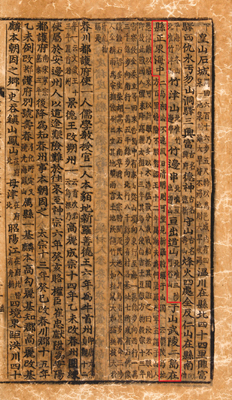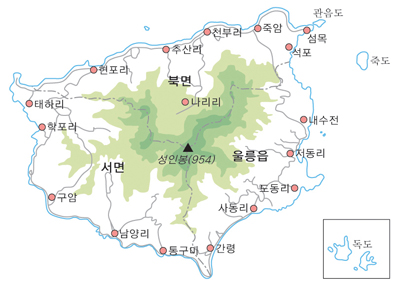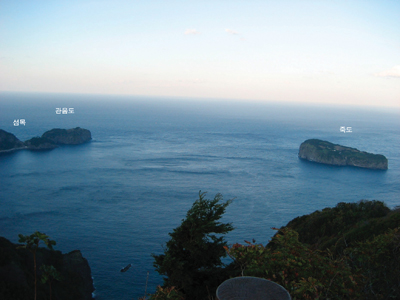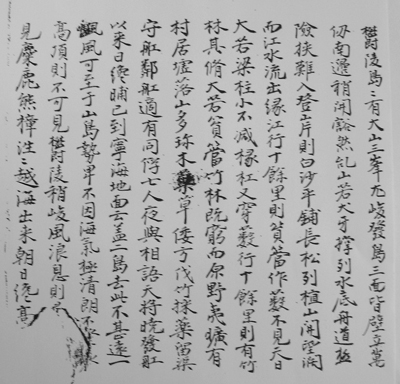- Dokdo in the East Sea
- Educational material
- High School Version
Dokdo in the East Sea
Table of Contents Open Contents
1. Dokdo in Historical Records
-
- Objectives
-
Examine how Dokdo is described in Korean historical records.
Explain the administrative policies called “retrieval policy” and “search policy.”
-
- Critical Thinking
-
Dokdo and Ulleungdo appear together in historical records and maps. Records indicate that Usando (Dokdo) is visible from Ulleungdo, thus people have long been aware of the islet’s existence. But, from when?
The Earliest Document to Record Dokdo
The earliest extant Korean document that contains records about Dokdo is History of the Three Kingdoms (1145). This book describes how General Kim Isabu of Silla annexed Usan. Ulleungdo and Dokdo were known as the “State of Usan” in the Three Kingdoms period. When people from Usan invaded and plundered the Silla mainland, Ichan (General)General Isabu conquered Usan. The people of Usan relied on the island’s harsh environment for defense. However, Isabu devised a clever plan to conquer Usan and force them to pay an annual tribute to Silla.
The following excerpt can be found in History of the Three Kingdoms, vol. 4, Silla Section 4, in the sixth month of the thirteenth year of the reign of King Jijeung (512).
-
Usan surrendered in the sixth month of the thirteenth year of King Jijeung (512) and paid annual tribute thereafter. Usan is an island located directly east of Myeongju and is also referred to as Ulleungdo. The land is 100 ri (40 kilometers) in width and length. The people in Usan relied on the island’s harsh environment for defense and refused to submit to Silla. General Isabu stated upon becoming the king of Hassla, “The residents of Usan are foolish and stubborn, and they will not willfully surrender. Therefore, a scheme must be devised to force their submission.” Thus, General Isabu ordered the construction of wooden lions to take aboard his ships and entered the waters of Usan. He stated, “If you do not surrender, I will release these wild beasts upon your land for you to be trampled to your deaths.” Usan surrendered immediately.
Ulleungdo and Dokdo in the Goryeo Period
When the Goryeo Dynasty was established in 918, Usan become part of Goryeo territory. In 930, the State of Usan sent two officials, Baek Gil and To Du, to pay tribute and remained under Goryeo rule.
After an invasion by the Northeast Jurchens in 1018, Usan faced difficulties in agriculture. Goryeo supported Usan by dispatching a special envoy with farming equipment and seeds. In 1032, the general of Wooreungdo (Ulleungdo) sent his son to pay tribute to Goryeo.
In 1157, King Uijong sent Myeongjudo’s Kim Yu-rip on an excursion to verify whether Ulleungdo was suitable for habitation. After surveying the surface area, villages, sites, and resources, Kim Yu-rip returned and reported to the king that Ulleungdo was too rocky and unsuitable for habitation. The Goryeo government attempted several times to send people to Ulleungdo to inhabit the island, but numerous casualties resulting from storms stopped the efforts. Due to the residents’ difficulties with the living conditions and continuous foreign invasions, the government dispatched an Anmusato Ulleungdo for administrative duties.
In Goryeo-period records, Ulleungdo appears as Wooreung(do) and Mureung(do), and Dokdo appears as Usan. Usan (Dokdo) and Mureung (Ulleungdo) are listed as separate islands in History of Goryeo Geographical Records (1451).
-
一云 于山武陵本二島 相距不遠 風日淸明 則可望見
Someone said, Usan (Dokdo) and Mureung (Ulleungdo) are two separate islands, and they are close enough that the other is visible on a clear day.
Ulleungdo and Dokdo in the Joseon Period
Several records about Ulleungdo and Dokdo are extant from the Joseon period. As people had long resided in Ulleungdo, the government never stopped receiving reports about Ulleungdo in the Joseon period. However, the government was unable to oversee the people residing in Ulleungdo. The island’s residents were an easy target for foreign invasions, and some people fled there to avoid paying taxes. The government introduced a “retrieval policy”Retrieval Policyfor Ulleungdo residents. Although Ulleungdo thus became an uninhabited island, this was an effort to govern Ulleungdo and its surrounding islands, and not an abandonment of the territory.
Despite the retrieval policy, people continued to reside on Ulleungdo, and the island was never truly uninhabited. Anmusa An’s government post was “Anmusa Official to Mureung” or “Anmusa Official to Usan and Mureung.” As his title suggests, Anmusa An was not only in charge of investigating Ulleungdo, but Usando (Dokdo) as well. In the late Joseon period, the government dispatched a Search Official every three years and a Search Policy was instituted.
The “retrieval policy” and the “search policy” were different from the “empty island policy.” These administrative policies were introduced to maintain a central government system. However, Japan intentionally uses the term “empty island policy” to insinuate that the Joseon government intended to abandon its territory.
The Relationship between the Two Islands is Revealed in The Annals of King Sejong Geographical Records
In the early Joseon period, the government compiled geographical records of the entire country. The Newly Compiled Geographical Description of the Eight Provinces (1432) preceded the compilation of The Annals of King Sejong Geographical Records (1454). This text contained information about Ulleungdo and Usando.
-
于山武陵 二島在縣正東海中 二島相去不遠 風日淸明 則可望見 新羅時稱于山國 一云鬱陵島
Usan (Dokdo) and Mureungdo (Ulleungdo) are in the middle of the sea directly east of Uljin. The two islands are close enough that the other is visible on a clear day. The island was called Usan during the Silla period, but it is also referred to as Ulleungdo.
-
- Activity 1
-
Investigate why “Usan” in History of the Three Kingdoms is called “Dokdo” in The Annals of King Sejong Geographical Records.
The Importance of The Annals of King Sejong Geographical Records
Information in The Annals of King Sejong Geographical Records describes Usan (Dokdo) and Mureung (Ulleungdo) as two separate islands. This excerpt, “The two islands are close enough that the other is visible on a clear day,” suggests that the islands are not so close that they would not be visible on a foggy day.
Among the islands near Ulleungdo are Gwaneumdo and Jukdo. Gwaneumdo is located near the tip (Island Neck) of Ulleungdo and is sometimes referred to as Kkakse Island. Jukdo is located approximately four kilometers northeast of Ulleungdo. An inhabited island, travel by boat from Ulleungdo to Jukdo takes approximately 15 minutes. It is also known as “Jukdo” or “Bamboo Island” because of its dense bamboo forests. These two islands are close enough that the other may be seen even in foggy conditions. Therefore, the island mentioned in The Annals of King Sejong Geographical Records clearly does not indicate either Gwaneumdo or Jukdo. Similar to History of the Three Kingdoms, The Annals of King Sejong Geographical Records mentions General Isabu’s annexation of Usan, which indicates the recognition and importance of Ulleungdo and Usando.
-
- Activity 2
-
Identify which islands are near Ulleungdo. Explain why the island mentioned in The Annals of King Sejong Geographical Records does not indicate either Gwaneumdo or Jukdo.
Historical Sources after The Annals of King Sejong Geographical Records
The New and Expanded Complete Conspectus of the Territory of the Eastern Country was compiled in 1531, and it too includes references to Ulleungdo and Dokdo. The title “Usando, Ulleungdo” obviously refers to the two islands.
-
于山島 鬱陵島
一云武陵 一云羽陵 二島在縣正束海中 三峯嶪撑空 南峯梢卑 風日淸明 則峯頭樹木及山根沙渚 歷歷可見 風便則二日可到 一說于山鬱陵本一島地方百里
The island is called Mureung as well as Wooreung. Ulleungdo is located directly east of Uljin. Three peaks stand high, with the southern peak being the shortest. On a clear day, the sandbar and the trees on the mountain peak can be vividly seen, and the island can be reached in two days in a fair wind. The island is about 40 kilometers in width and length.
Historical Records That Specifically Mention ‘Usando’
Specific mention of “Usando” began with the “An Yong-bok Incident.” During the reign of King Sukjong, a government official named Park Se-dang Se-dang Pak (1629-1703) noted the following in “Ulleungdo.”
-
The two islands are close enough from here (Pyeonghae, mainland) that they can easily be reached in a strong wind. Usando’s topography is low, thus unless the weather is clear or one is looking from the highest point (from Ulleungdo), the island is not visible. Ulleung is slightly higher, thus it can be seen from the mainland in clear weather.
-
- Activity 3
-
The two islands that Park Se-dang wrote about were Ulleungdo and Usando. Investigate the reason why Usando would be visible from Ulleungdo using the information in The Annals of King Sejong Geographical Records and Park Se-dang’s records in “Ulleungdo.”
Dokdo in Notes on Joseon’s Frontiers
The scholar from the late Joseon period, Gyung Joon Sin (1712-1781), wrote Notes on Joseon’s Frontiers (1756).
-
按輿地志云 一說于山鬱陵本一島 而考諸圖志二島也 一則其所謂松島 而盖二島俱是于山國也
“It is written in Joseon Gazetteer that ‘Usan and Ulleung are in fact one island. However, a study of multiple maps indicates that they are two separate islands. One of the islands is what foreigners call Songdo (Matsushima, Dokdo).’ Both islands are part of Usan.”
-
- Activity 4
-
Explain why Usando is included in Usan using information from History of the Three Kingdoms and Notes on Joseon’s Frontiers.
Ichan (General)
Second highest official rank of the 17 government positions during the Silla period.
닫기
Myeongju
Currently in the Gangneung area, Usan was part of Myeongjudo in the Goryeo period.
닫기
Hassla,
A local government during the Silla period, it is now the Gangneung area.
닫기
Anmusa
A temporary official dispatched by the government from the Goryeo period through the early Joseon period to investigate the difficulties of residents and government misconduct.
닫기
Retrieval Policy
A government policy to bring residents back to the mainland as a protective measure and to restrict people from residing on the island.
닫기
Search Official
A government official in charge of seeking out people on the island and returning them to the mainland. Officials from Samcheok and Uljin counties were sent in rotation.
닫기
Search Policy
Another government policy was to search and bring people back to the mainland. The term emphasizes administration over the island. This policy was essentially a continuation of the retrieval policy.
닫기
Island Neck
The name refers to Ulleungdo’s “neck” area.
닫기
Se-dang Pak
Nam Gu-man, a government official in the late Joseon period who was involved in the An Yong-bok Incident, was Park’s brother-in-law. It is believed that Park learned about Usando (Dokdo) through this connection.
닫기
Gyung Joon Sin
A scholar from the Joseon period and active during the reign of King Yeongjo, he was in charge of the “Geography Study” for the Reference Documents on the Eastern Country. The section for “Usando” can be directly attributed to the records in Notes on Joseon’s Frontiers.
닫기



















